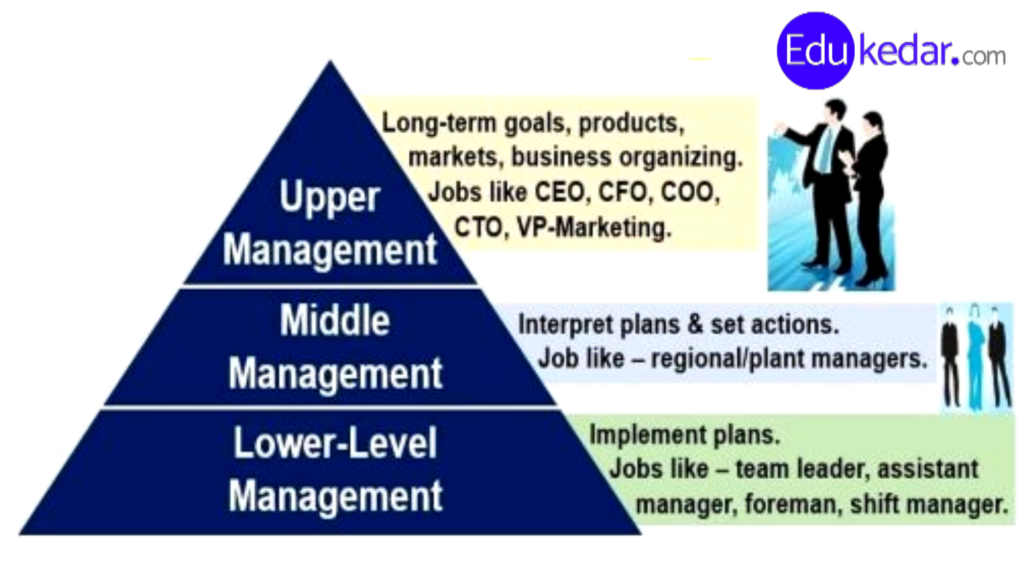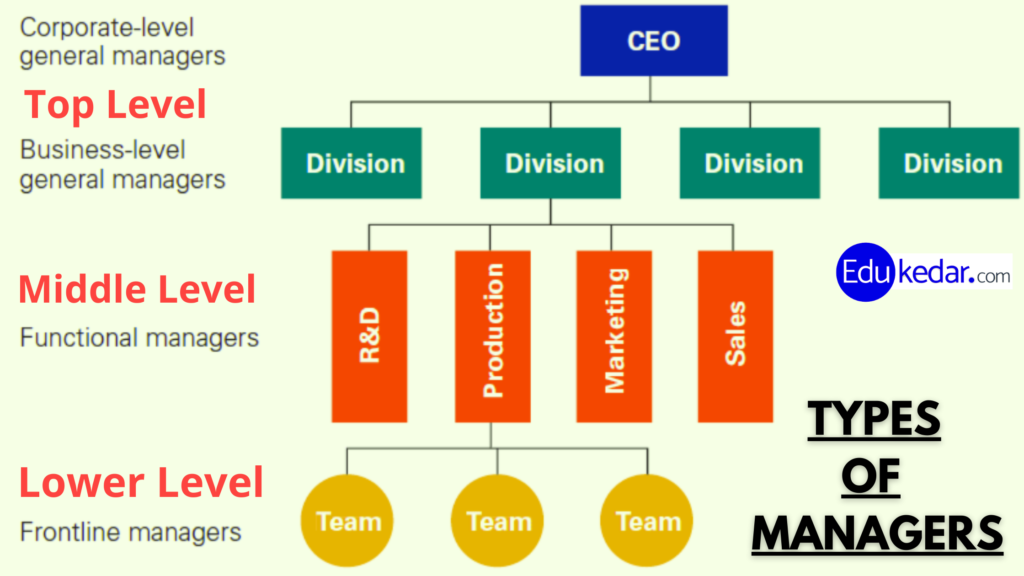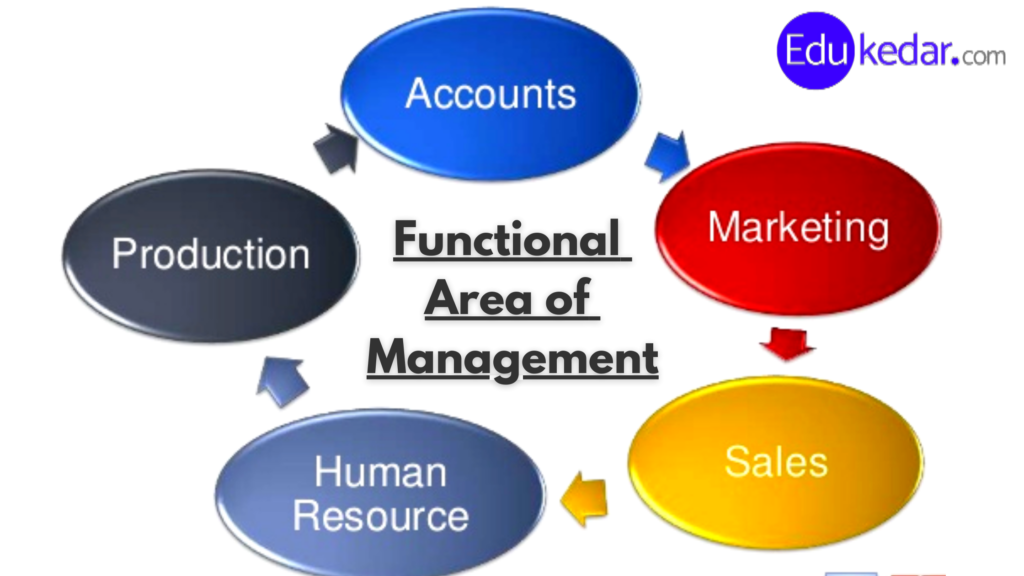Multi-national companies (MNC) and business organizations often have three primary levels of management organized in a hierarchical structure. Managerial functions in a number of roles including leading, sharing information, and making decisions. How often they play a particular role depends on the position of the level they occupy and the type of organization.
We have seen earlier that five management functions – planning, organizing, staffing, directing, and controlling are performed by every manager in an organization. However, the relative importance of these functions varies along with the managerial levels.
This article will help you to understand levels of management and their responsibilities according to various managerial positions in the organization.
Levels of Management

“Edward Francis Leopold Brech” was a British management consultant and author who first classified management levels into three categories.
Levels of Management can be divided into three categories:
- Top Level Management
- Middle-Level Management
- Lower Level Management
1. Top Level Management:
Top Management consists of all functions of the Chairmen, Board of Directors, and Chief Executives. Top-level management (or top managers) are the “bosses” of the organization.
- It is the Topmost layer of the management hierarchy.
- They need to set the Long-term goals of the organization.
- Top management develops Strategic plans and company-wide policy.
- They integrate the functions of the whole organization.
- They are responsible for overall management.
Top management is ultimately responsible for the long-term success of the organization. They set long-term goals of the organization and define strategies to achieve them. They pay careful attention to the external environment of the organization like the economy, stakeholder demands, and consumer and public relations.
Top Management has titles such as chief executive officer (CEO), chief operations officer (COO), chief marketing officer (CMO), chief technology officer (CTO), and chief financial officer (CFO). They make major decisions about the direction of the organization at the highest level.
2. Middle-level management:
Middle management plays the role of mediator between Top and first-line management hierarchy. Top management delegates a major part of his authority and responsibility to middle management.
- They are Mediators between top to Lower management.
- They are overseen by Top management.
- It has the largest group of managers in most organizations.
- Provide Training and Development of employees.
- They Communicate the strategic goals to front-line management.
Middle management receives broad strategic plans from top management and turns them into operational blueprints with specific objectives and programs for front-line managers.
In some big organizations like MNC’s, middle management may have two categories that are senior and junior middle-level managers.
This is also known as Upper-middle level (senior) and Lower-middle level (junior) management.
- At the Upper middle-level management, the basic divisions of the organization are determined and overall programs of a department are established.
- At the Lower middle-level management, the primary concern is to carry out functions for achieving specific goals.
Middle management includes those working in the roles of departmental heads like Production manager, HR manager, Marketing Manager, Finance Manager, Regional manager, and Branch manager.
Must Read ➜ 10 Roles of Managers
3. First-Line or Lower-level management:
Supervisory / front-line / First-line management is the entry-level of management. It is also known as Supervisory Management. They are “on the line” and in the closest contact with the workers.
- Lower level management is the lowest in the three layers.
- They ensure the quality of ongoing work of workers.
- The Keep day-to-day supervision.
- They do career planning for their team.
- Provides feedback on their employees’ performance.
They are responsible for overseeing the everyday work of individual staff members and providing them with direction on their work.
First-line managers are focused almost exclusively on the internal issues of the organization. They are the first to see problems with the operation of the business, such as untrained labor, poor quality materials, machinery breakdowns, or new procedures that slow down production.
This level can be classified into three categories, particularly in a large-sized organization;
- Senior supervisor,
- Intermediate supervisors, and
- Front-line supervisors.
Lower-level/ First-line management is directly responsible for making sure that organizational objectives and plans are implemented effectively. It is essential that they communicate regularly with middle management.
Must Read ➜ What is Management?
First-line or Low-level management has job roles such as Supervisors, Technicians, Controllers, Shift managers, foremen, Section chiefs, Team Leaders.
Types of Managers (Management Levels)

Managers can be classified in two ways: by their level within the organization and by the scope of their work and responsibilities.
These Managers are classified according to a hierarchy of authority and perform different tasks. In many organizations, the number of managers at each level gives the organization a pyramid structure.
Most business organizations have three levels of Managers:
- Top-Level Managers (General Managers)
- Middle-level Managers (Functional Managers)
- Lower or first-level Managers (Front Line Managers)
Functional Area of Management
The number and types of functional areas of management are determined by the nature of the organization and the types of classifications of various activities.
According to various Management education reports, functional management areas can be divided into many parts: Production, Finance, Development, Logistics (distribution), Marketing, Transport, Maintenance, Human resource (HR), Office & administration, Information Technology (IT). This classification is very intensive.
A more acceptable and practicable classification includes four broad functional areas –

Production, Sales and Marketing, Finance, and Personnel or Human resource.
Must Read ➜ Types of Managerial Skills
These areas have their own organization, policies, procedures, and sub-activities.
Production
Production is the area that is normally kept under the control of a production manager who is responsible for the performance of entire related activities like purchasing, material management, Research, and Development.
Sales And Marketing
The marketing area involves the distribution of the organization’s product to the buyers. This requires a number of steps and can be divided into subareas like advertising, marketing research, sales management.
Finance And Accounting
This area deals with the record-keeping of various transactions and management of financial resources of the organization. It consists of financial accounting, management accounting, costing, investment management, taxation.
Human Resource
Human resource or personnel function deals with the management of human beings in the organization. It has HR activities like recruitment and selection, training and development, Industrial Relations, wages, and salary administration.
The classification of the above functional areas does not necessarily support that an organization division listed on the functional basis will have all these departments. This, however, is determined by the specific need of the organization.





